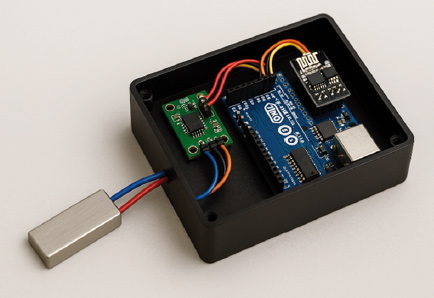Wireless deformation monitoring system using strain sensor based on silicon whiskers
Abstract
Structural health monitoring of steel pipelines in industrial environments remains a critical challenge due to mechanical loads, pressure variations, temperature fluctuations, and external degradation. Traditional foil strain gauges, though widely used and inexpensive, suffer from thermal instability, limited operational life under cyclic loading, and the need for hermetic protection, restricting their application in infrastructure monitoring. Optical fiber sensors offer high precision, but are costly and difficult to integrate. This paper presents a wireless deformation monitoring system based on silicon whiskers used as strain-sensitive elements embedded into a Wheatstone bridge. One of the bridge’s four arms includes a silicon whisker sensor, while the others use 350 Ω precision tantalum resistors, ensuring thermal stability. The analogue output of the bridge is amplified and digitized by an HX711 ADC and processed by an Arduino-compatible microcontroller, which transmits the data via Wi-Fi. For thermal compensation, a “bridge within a bridge” configuration is used, allowing real-time correction of temperature-induced drift.
Experimental validation was carried out on a water pipeline segment under simulated pressures of up to 12 bar. The silicon whisker-based sensors demonstrated a stable gauge factor of ~120 ± 10% and a thermal resistance drift within +(0.1 ± 0.02)%/°C over the temperature range from −150 to +200 °C. The system reliably measured strain up to ±5ꞏ10⁻³ (0.5%), matching expected deformations in steel pipeline applications. The results of the extended temperature test showed that when heated to +350°C, the measurement error caused by the temperature coefficient of resistance does not exceed 1.2% after digital correction. Therefore, for the practical system, a “bridge-in-a-bridge” thermal compensation scheme was used, where one of the arms acts as a reference thermal control link.
The proposed system offers a compact solution for real-time strain monitoring in industrial settings. Its wireless functionality, thermal resilience, and measurement precision make it highly suitable for continuous diagnostics and early fault detection.
References
Kralovec C., Schagerl M. Review of structural health monitoring methods regarding a multi-sensor approach for damage assessment of metal and composite structures. Sensors, 2020, vol. 20, no. 3, article 826. https://doi.org/10.3390/s20030826
European Pipeline Incident Study 2024. EPRS, Brussels, 2025, 112 p.
HBM GmbH. Drift in Bonded Foil Strain Gauge-Based Sensors. Hottinger Baldwin Messtechnik GmbH; 2025. Available at: https://www.hbm.com/tw/6218/drift-in-bonded-foil-strain-gauge-based-sensors
Fan Y., Shen Z., Zhou X. et al. Highly sensitive strain sensor from topological-structure modulated dielectric elastic nanocomposites. Advanced Electronic Materials, 2022, vol. 7, iss. 1, article 2101190. https://doi.org/10.1002/admt.202101190
Wu T., Liu G., Fu Sh., Xing F. Recent progress of fiber-optic sensors for the structural health monitoring of civil infrastructure, Sensors, 2020, vol. 20, iss.16, article 4517. https://doi.org/10.3390/s20164517.
HBM GmbH. An analysis of the cost-effectiveness of optical-technology systems. Hottinger Brüel & Kjær, 2024. Available: https://www.hbm.com/en/9280/cost-effectiveness-of-optical-technology/
Flores-Bravo J.A., Madrigal J., Zubia J., Sales S., Villatoro J. Coupled-core fiber Bragg gratings for low-cost sensing. Scientific Reports, 2022, vol. 12, article 1280. https://doi.org/10.1038/s41598-022-05313-9
Druzhynin A.O., Maryamova I.I., Kutrakov O.P. [Sensors of mechanical quantities based on filamentary crystals of silicon, germanium and A3B5 compounds]. Lviv: Publishing House of Lviv Polytechnic National University, 2015. 232 p. (Ukr)

Copyright (c) 2025 Anatoliy Druzhinin, Roman Koretskyi, Stepan Nichkalo, Danylo Talanchuk

This work is licensed under a Creative Commons Attribution 4.0 International License.
